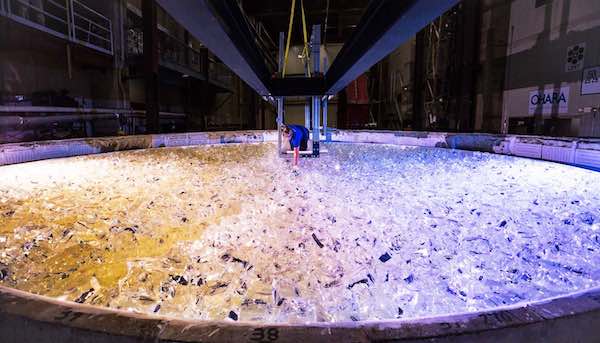
[Image above] Credit: Giant Magellan Telescope – GMTO Corporation
The Giant Magellan Telescope, when completed and operational in 2023, will be the world’s largest telescope—and it will search the cosmos for signs of biological life from its installation in the Atacama Desert in Chile.
It will be one of a few pieces of equipment that can do so, and that’s thanks to the telescope’s unprecedented light-gathering skills. The completed telescope will consist of seven 27.5-ft mirrors, arranged together in a flower pattern. Together, those seven mirrors give the telescope a light-gathering area of about 360 m2—just smaller than a basketball court.
But to build a giant, incredible telescope, you first need to build giant, incredible mirrors. And that process is currently underway at the Richard F. Caris Mirror Lab at the University of Arizona (Tuscon, Ariz.).
Like the telescope they will eventually build, these are no regular mirrors—they’re the world’s lightest and largest telescope mirrors, being built with a unique spin-casting technique that takes two months.
According to a University of Arizona news story, each mirror is fabricated from 40,800 pounds of specialty glass, custom manufactured by Ohara Corp. in Japan.
The first step to fabricating the mirrors is to carefully inspect each glass chunk within the shipment of 1,632 boxes of Ohara Corp. glass, each weighing about 25 pounds. Then mirror lab technicians arrange, by hand, the 40,000-plus pounds of glass chunks onto the base of a huge furnace.
Check out the painstaking process in the short time-lapse video below.
Credit: Giant Magellan Telescope; YouTube
Once the glass chunks are in place, the lab’s technicians assemble the furnace on top. The one-of-a-kind furnace—built in 1984 and containing 270 heaters—slowly fires the irregular glass pieces, transforming them into a beautifully smooth and precise telescope mirror. The furnace gently spins as it slowly fires the glass, fabricating the mirror with a precise parabolic shape.
The first week of the two-month casting process is spent slowly heating up the glass to 1,165ºC, while the furnace gently spins at around five revolutions per minute. After a few days, the furnace temperature is reduced to about 700ºC, where the glass will spend the next several weeks annealing at a slightly lower spinning speed.
After a couple months, the jagged chunks of glass that entered the huge furnace emerge as a singular, precise glass piece with a unique honeycomb structure and a parabolic shape.
“Not only are these mirrors so light they could float in water, but they are very stiff and quickly adjust to changes in nighttime air temperature, each resulting in sharper images,” according to the news story.
The mirror lab is currently casting its fifth mirror, with three more to go (7 total mirrors for the completed telescope, plus a spare). Once completed, the mirrors together with an advanced optics system will help the telescope explore the worlds outside our planet with its ability to capture images 10 times sharper and 100 times faster than the Hubble Space Telescope.
“The telescope will allow astronomers to answer some of the most pressing questions about the cosmos, including the detection, imaging and characterization of planets orbiting other stars; the nature of dark matter and dark energy; the physics of black holes; and how stars and galaxies evolved during the earliest phases of the universe,” according to the news story.
For more information and for a beautiful slideshow of the casting process, head over here.
Did you find this article interesting? Subscribe to the Ceramic Tech Today newsletter to continue to read more articles about the latest news in the ceramic and glass industry! Visit this link to get started.



